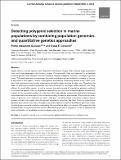Files in this item
Detecting polygenic selection in marine populations by combining population genomics and quantitative genetics approaches
Item metadata
| dc.contributor.author | Gagnaire, Pierre-Alexandre | |
| dc.contributor.author | Gaggiotti, Oscar Eduardo | |
| dc.date.accessioned | 2016-09-06T09:30:09Z | |
| dc.date.available | 2016-09-06T09:30:09Z | |
| dc.date.issued | 2016-12 | |
| dc.identifier.citation | Gagnaire , P-A & Gaggiotti , O E 2016 , ' Detecting polygenic selection in marine populations by combining population genomics and quantitative genetics approaches ' , Current Zoology , vol. 62 , no. 6 , pp. 603-616 . https://doi.org/10.1093/cz/zow088 | en |
| dc.identifier.issn | 1674-5507 | |
| dc.identifier.other | PURE: 245138796 | |
| dc.identifier.other | PURE UUID: c98549a9-6eac-48ea-93f6-13673894bc76 | |
| dc.identifier.other | Scopus: 85010402682 | |
| dc.identifier.other | WOS: 000394508100009 | |
| dc.identifier.other | ORCID: /0000-0003-1827-1493/work/61370072 | |
| dc.identifier.uri | https://hdl.handle.net/10023/9435 | |
| dc.description | P-AG was supported by the CNRS-INEE action APEGE (ArchiGen). OEG was supported by the Marine Alliance for Science and Technology for Scotland (MASTS). | en |
| dc.description.abstract | Highly fecund marine species with dispersive life-history stages often display large population sizes and wide geographic distribution ranges. Consequently, they are expected to experience reduced genetic drift, efficient selection fueled by frequent adaptive mutations, and high migration loads. This has important consequences for understanding how local adaption proceeds in the sea. A key issue in this regard, relates to the genetic architecture underlying fitness traits. Theory predicts that adaptation may involve many genes but with a high variance in effect size. Therefore, the effect of selection on allele frequencies may be substantial for the largest effect size loci, but insignificant for small effect genes. In such a context, the performance of population genomic methods to unravel the genetic basis of adaptation depends on the fraction of adaptive genetic variance explained by the cumulative effect of outlier loci. Here, we address some methodological challenges associated with the detection of local adaptation using molecular approaches. We provide an overview of genome- scan methods to detect selection, including those assuming complex demographic models that better describe spatial population structure. We then focus on quantitative genetics approaches that search for genotype-phenotype associations at different genomic scales, including genome-wide methods evaluating the cumulative effect of variants. We argue that the limited power of single locus tests can be alleviated by the use of polygenic scores to estimate the joint contribution of candidate variants to phenotypic variation. | |
| dc.format.extent | 14 | |
| dc.language.iso | eng | |
| dc.relation.ispartof | Current Zoology | en |
| dc.rights | Copyright The Author (2016). Published by Oxford University Press. This is an Open Access article distributed under the terms of the Creative Commons Attribution Non-Commercial License (http://creativecommons.org/licenses/by-nc/4.0/), which permits non-commercial re-use, distribution, and reproduction in any medium, provided the original work is properly cited. For commercial re-use, please contact journals.permissions@oup.com | en |
| dc.subject | Local adaptation | en |
| dc.subject | Genome scans | en |
| dc.subject | Quantitative genetics | en |
| dc.subject | Genotype-phenotype association | en |
| dc.subject | Polygenic scores | en |
| dc.subject | GC Oceanography | en |
| dc.subject | QH426 Genetics | en |
| dc.subject.lcc | GC | en |
| dc.subject.lcc | QH426 | en |
| dc.title | Detecting polygenic selection in marine populations by combining population genomics and quantitative genetics approaches | en |
| dc.type | Journal article | en |
| dc.description.version | Publisher PDF | en |
| dc.contributor.institution | University of St Andrews. School of Biology | en |
| dc.contributor.institution | University of St Andrews. Marine Alliance for Science & Technology Scotland | en |
| dc.contributor.institution | University of St Andrews. Scottish Oceans Institute | en |
| dc.identifier.doi | https://doi.org/10.1093/cz/zow088 | |
| dc.description.status | Peer reviewed | en |
This item appears in the following Collection(s)
Items in the St Andrews Research Repository are protected by copyright, with all rights reserved, unless otherwise indicated.

